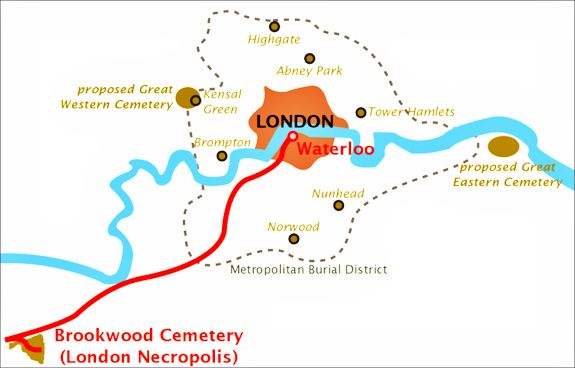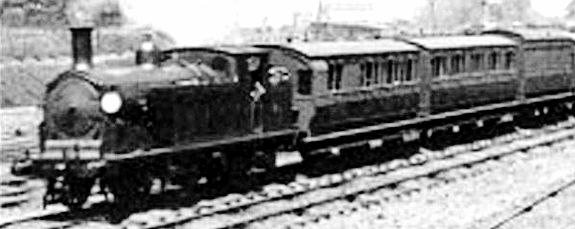
World's first funeral railway
121 Westminster Bridge Road, London SE1 7HR
The population of London had rocketed from less than a million people in 1801 to two and a half million in 1851, but the 300 acres of available burial space remained unchanged, with even relatively fresh graves exhumed to free up space for new burials. The resulting contamination of water supplies and epidemics of cholera, smallpox, measles and typhoid led to the establishment of a Royal Commission; it concluded in 1842 that London's burial grounds had become so overcrowded that it was impossible to dig a new grave without cutting through an existing one. Following a cholera epidemic in 1848‘“49, which killed 14,601 Londoners, the Act to Amend the Laws Concerning the Burial of the Dead in the Metropolis (Burials Act) was passed in 1851, prohibiting new burials in built-up areas of London.
Sir Richard Broun and Richard Sprye proposed the construction of an enormous cemetery at Brookwood, to be named the London Necropolis, setting any health hazards well away from the capital. The London and South Western Railway (LSWR) had connected London to Woking in 1838; the speed of the railway made it both quicker and cheaper to reach than the seven existing cemeteries, all of which required slow and expensive horse-drawn hearses. In 1852 Parliamentary consent to proceed was granted and the London Necropolis and National Mausoleum Company (LNC) was formed; to prevent any abuse of monopoly power, the Act bound the LSWR to carry corpses and mourners to the cemetery in perpetuity and set a maximum tariff which could be levied on funeral traffic.

The world's largest cemetery was opened on 7 November 1854 on what had been Woking Common. Six days later, the first scheduled funeral train left the new London Necropolis railway station for the one hour journey to the cemetery for the burial of stillborn twins; the London Necropolis Railway ran on the existing LSWR track, via a dedicated branch line into Brookwood Cemetery. Siting the London terminus near the LSWR's recently-opened London terminus at Waterloo Bridge station (now London Waterloo) allowed the cheap transport of bodies by water and road and the arches of the huge LSWR brick viaduct were readily convertible into mortuaries. Despite objections from local residents, the LNC purchased a plot of land between Westminster Bridge Road and York Street (now Leake Street) for the site. The elegant design, incorporating ornate gates originally designed for the Great Exhibition was the product of William Tite and William Cubitt and was completed in October 1854.
Specifically designed for the sensitivities of mourners, the London Necropolis railway station incorporated many private waiting rooms which could also be used to hold funeral services, and a hydraulic lift to raise coffins to platform level. A private access road allowed mourners to arrive and leave discreetly. The ground floor contained a grand entrance hall and staircase for mourners attending first and second class funerals; a smaller entrance hall and staircase met the needs of those attending lower classes of funeral. Two mortuaries occupied the majority of the floor, along with a store room holding 300 coffins. Outside, a glass roof was positioned so that no shadow was cast on the hearse or carriage waiting at the platform; the western wall was windowless so that passengers using the LSWR station could not peer into the Necropolis station.
On arrival at Brookwood Cemetery, trains reversed down the branch line to one of two stations within the cemetery - one dedicated for the burial of Anglicans, the other for Nonconformists and non-believers. The station waiting rooms and the compartments of the train were partitioned by both religion and class to prevent both mourners and cadavers from different social backgrounds from mixing. The railway also transported very significant numbers of exhumed bodies during the mass removal of a number of London graveyards to Brookwood.
LNC’s London terminus became an increasing irritant to the LSWR, preventing much-needed expansion of the number of lines serving Waterloo station. In 1896, LNC offered to give up their existing station if LSWR allowed them to design the new building, to be leased for a peppercorn rent in perpetuity; the LSWR would also provide new rolling stock, provide the free carriage of machinery and equipment to be used in the cemetery and remove any limit on passenger numbers. The LSWR agreed - reluctantly - and construction of the new facility began in 1900. Designed by the LNC's General Manager, Cyril Bazett Tubbs, the narrow frontage on Westminster Bridge Road incorporated the LNC’s four-story headquarters building, with first class mourners entering through an archway under the offices. The driveway ran past mortuaries and storerooms to the lifts and stairs to the platforms, and also to a secondary entrance on Newnham Terrace. The first class platform offered five separate waiting rooms to keep apart mourners from different funeral parties separate. The third class section was entered from the secondary entrance in Newnham Terrace, and was more sparsely furnished and offered a single communal waiting room on the first floor. The railway moved into the new building in 1902 and the earlier station was demolished.
An air raid on the night of 16 April 1941 rendered much of the station building and the tracks to the station unusable. Westminster Bridge Road station was never used again, with a declining number of funeral trains running from Waterloo station. Following the end of the war the London Necropolis Company decided that re-opening the London Necropolis Railway was not financially worthwhile; by 1948 the tracks had been lifted from the private branches off the mainline. The two stations in the cemetery were converted into bars for use by funeral parties, but the North bar was demolished during the 1960s due to dry rot and the South bar became disused and eventually burnt down in 1972. The platforms and the associated chapels of both cemetery stations still survive. The surviving frontage of the London terminus building was sold as office space and remains intact and largely in its original form. The building was Listed Grade II in 1989.

John Clarke, The Brookwood Necropolis Railway, Oakwood Press, ISBN-10: 0853616558 (2006)
Faulkner, J. N. & Williams, R. A., The London and South Western Railway in the Twentieth Century, David & Charles, ISBN-10: 0715389270 (1988)
Oliver Green, Discovering London Railway Stations, Shire, ISBN-10: 0747808066 (2010)
Hugh Meller & Brian Parsons, London Cemeteries: An Illustrated Guide & Gazetteer, The History Press, ISBN-10: 0752461834 (2011)
Nock, O. S., London and South Western Railway, Littlehampton Book Services, ISBN-10: 0711002673 (1972)
Ben Pedroche, Do Not Alight Here: Walking London's Lost Underground and Railway Stations, Capital Transport Publishing, ISBN-10: 1854143522 (2011)
Jesse Russell & Ronald Cohn, London Necropolis Company, Book on Demand, ISBN-10: 5510535466 (2012)
British Listed Buildings - Listing for Westminster Bridge House
The Brookwood Cemetery Society
London Necropolis Railway Map showing the short branch from 1902 terminus to London Waterloo 
Plan of Westminster Bridge Road Station 
St Edward The Martyr Orthodox Brotherhood - Monastic community, Brookwood